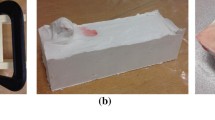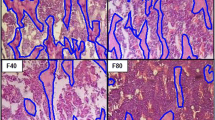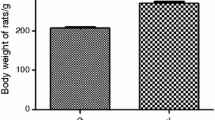Abstract
The relationships between bone mineral content (BMC), bone calcium, and bone strength were studied in fractionally demineralized feline femurs. In 44 pairs of cat femurs, the right bones were decalcified in ethylene diaminetetra acetic acid (EDTA) to 20%, 40%, 60%, 80%, and 100% of the mineral content of the intact left bone (=control). The bones were then loaded to failure, and maximum strength values were recorded. The data were then used to calculate the percentage strength of the right relative to the left femurs. A correlation coefficient (r) of 0.970 was found between the percentage decalcification and percentage bending strength. A direct relationship (r=0.876) was also observed between the total calcium extracted and total loss in BMC. The EDTA solutions were spot checked for protein content to determine if the organic matrices had been altered by demineralization. Protein was never detected. Nor did the demineralized tissues display histologic evidence of gross microscopic damage. This study has shown that in cat femurs, 20% decalcification led to about 35% loss in bending strength, and 60% decalcification caused 75% loss in strength. These values are significant as they highlight the importance of calcium to the strength of osteopenic bone.
Similar content being viewed by others
References
Durbridge TC, Morris HA, Parsons AM, Parkinson IH, Moore RJ, Porter S, Need AG, Nordin BE, Vernon-Roberts B (1990) Progressive cancellous bone loss in rats after adrenalectomy and oophorectomy. Calcif Tissue Int 47(6):383–387
Barengolts EI, Gajardo HF, Rosol TJ, D'Anza JJ, Pena M, Botsis J, Kukreja SC (1990) Effects of progesterone on postovariectomy bone loss in aged rats. J Bone Miner Res 5(11): 1143–1147
Togari A, Arai M, Hironaka M, Matsumoto S, Shinoda H (1991) Effect of HEBP (1-hydroxyethylidene-1, 1-bisphosphonate) on experimental osteoporosis induced by ovariectomy in rats. Jpn J Pharmacol 56(2):177–185
Tuukkanen J, Jalovaara P, Vaananen K (1991) Calcitonin treatment of immobilisation osteoporosis in rats. Acta Physiol Scand 141(1):119–124
Pazzaglia UE, Zatti G, Gervaso P, Gatti A, Pio A (1990) Experimental osteoporosis in the rat induced by a hypocalcic diet. Ital J Orthop Traumatol 16(2):257–265
Swissa-Sivan A, Statter M, Brooks GA, Azevedo J, Viguie C, Azoury R, Greenfield C, Oman S, Leichter I, Zinker BA et al (1992) Effect of swimming on prednisolone-induced osteoporosis in elderly rats. J Bone Miner Res 7(2):161–169
Lieuallen WG, Weisbrode SE, Horst RL, Nagode LA (1990) The effects of uremia and dietary phosphorus on the bone of rats. Bone 11(1):41–46
Lieuallen WG, Weisbrode SE (1991) Effects of systemic aluminium on the resolution of a uremic and dietary phosphorus-dependent model of uremic osteomalacia in rats. J Bone Miner Res 6(7):751–757
Felsenfeld AJ, Machado L, Rodriguez M (1991) The effect of high parathyroid hormone levels on the development of aluminium-induced osteomalacia in the rat. J Am Soc Nephrol 1(7): 970–979
Rodriguez M, Felsenfeld AJ, Llach F (1989) The evolution of osteomalacia in the rat with acute aluminium toxicity. J Bone Miner Res 4(5):687–696
Clark DI, Crofts CE, Saleh M (1990) Femoral neck fracture fixation—comparison of a sliding screw with lag screws. J Bone Joint Surg (Br) 72-B:797–800
Goh JCH, Shah KM, Bose K (1992) Biomechanical study on femoral neck fracture fixation in relation to bone mass. In: Proc 7th Int Conf on Biomedical Engineering, 2–4 December 1992, Singapore, pp 439–441
Leichter I, Margulies JY, Weinreb A, Mizrahi J, Robin GC, Conforty B, Makin M, Bloch B (1982) The relationship between bone density, mineral content and mechanical strength in the femoral neck. Clin Orth Rel Res 163:272–281
Sartoris DJ, Commer FG, Kosek J, Gies A, Carter D (1985) Dual-energy projection radiography in the evaluation of femoral neck strength, density and mineralisation. Invest Radiol 5:476–485
Arnold W (1987) Possibilities of immunohistochemical investigation on human temporal bone. Acta Otolaryngol (suppl) 436: 62–68
Cook SF, Ezra-Cohn HE (1962) A comparison of methods for decalcifying bone. J Histochem Cytochem 10:560–563
Culling CFA, Allison RT, Barr WT (1985) In Cellular pathology technique, Butterworth & Co, p 414
Jonas J, Burns J, Abel EW, Cresswell MJ, Strain JJ, Paterson CR (1993) A technique for the tensile testing of demineralised bone. J Biomech 26(3):271–276
Jonsson R, Tarkowski A, Klareskog L (1986) A demineralization procedure for immunohistopathological use. EDTA treatment preserves lymphoid cell surface antigens. J Immunol Methods 88(1):109–114
Mukai K, Yoshimura S, Anzai M (1986) Effects of decalcification on immunoperoxidase staining. Am J Surg Pathol 10(6): 413–419
Wakisaka S, Ichikawa H, Nishimoto T, Matsuo S, Yamamoto K, Nakata T, Akai M (1986) A technique for decalcification and demonstration of substance P-like immunoreactivity. Stain Technol 61(1):39–42
Goh JCH, Ang EJ, Bose K (1989) Effect of preservation medium on the mechanical properties of cat bones. Acta Orthop Scand 60(4):465–467
Bradford MM (1976) A rapid and sensitive method for quantitation of microgram quantities of protein utilizing the principle of protein-dye binding. Analyt Biochem 72:248–254
Compton SJ, Jones CG (1985) Mechanism of dye response and interference in the Bradford protein assay. Anal Biochem 151(2):369–374
Marshall T, Williams KM (1992) Coomassie blue protein dye binding assays measure formation of an insoluble protein dye complex. Anal Biochem 204(1):107–109
Reilly DT, Burstein AH (1974) The mechanical properties of cortical bone. J Bone Joint Surg (Am) 56-A:1001–1022
Burstein AH, Zika JM, Heiple KG, Klein L (1975) Contribution of collagen and mineral to the elastic-plastic properties of bone. J Bone Joint Surg (Am) 57-A:956–961
Currey JD (1964) Three analogies to explain the mechanical properties of bone. Biorheology 2:1–10
Sweeney AW, Kroon RP, Byers RK (1965) Mechanical characteristics of bone and its constituents. ASME 65-WA/HUF-7
Piekarski K (1970) Fracture of bone. J Appl Physics 41:215–223
Burstein AH, Reilly DT, Martens M (1976) Aging of bone tissue: mechanical properties. J Bone Joint Surg (Am) 58-A:82–86
Mori S, Sawai T, Teshima T, Kyogoku MM (1988) A new decalcifying technique for immunohistochemical studies of calcified tissue, especially applicable to cell surface marker demonstration. J Histochem Cytochem 36(1):111–114
Tonnaer EL, Kuijpers W, Peters TA, Ramaekers FC (1990) Effect of EDTA on cytokeratin detection in the inner ear. J Histochem Cytochem 38(8):1223–1227
Kiviranta I, Tammi M, Jurvelin J, Saamanen AM, Helminen HJ (1984) Fixation, decalcification, and tissue processing effects on articular cartilage proteoglycans. Histochemistry 80(6):569–573
Chakkalakal DA, Lippiello L, Wilson RF, Shindell R, Connolly JF (1990) Mineral and matrix contributions to rigidity in fracture healing. J Biomech 23:425–434
Powell ES, Lawford PV, Duckworth T, Black MM (1989) Is callus calcium content an indicator of the mechanical strength of healing fractures? an experimental study in rat metartarsals. J Biomed Eng 11:277–281
Melton LJ, Wahner HW (1989) Defining osteoporosis (editorial). Calcif Tissue Int 45:263–264
Nordin BEC (1987) The definition and diagnosis of osteoporosis (editorial). Calcif Tissue Int 40:57–58
Author information
Authors and Affiliations
Rights and permissions
About this article
Cite this article
Shah, K.M., Goh, J.C.H., Karunanithy, R. et al. Effect of decalcification on bone mineral content and bending strength of feline femur. Calcif Tissue Int 56, 78–82 (1995). https://doi.org/10.1007/BF00298748
Received:
Accepted:
Issue Date:
DOI: https://doi.org/10.1007/BF00298748




